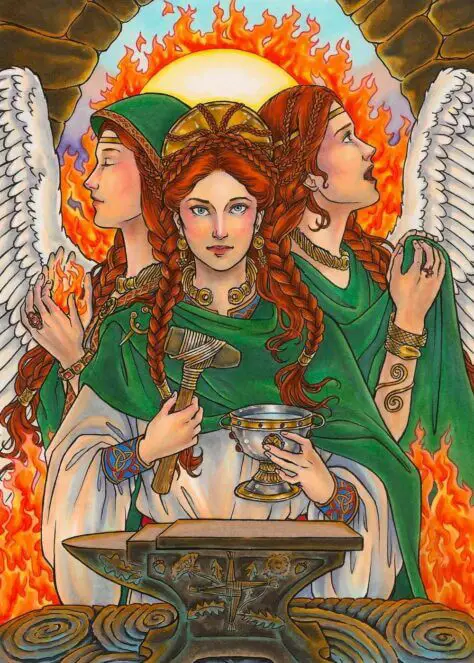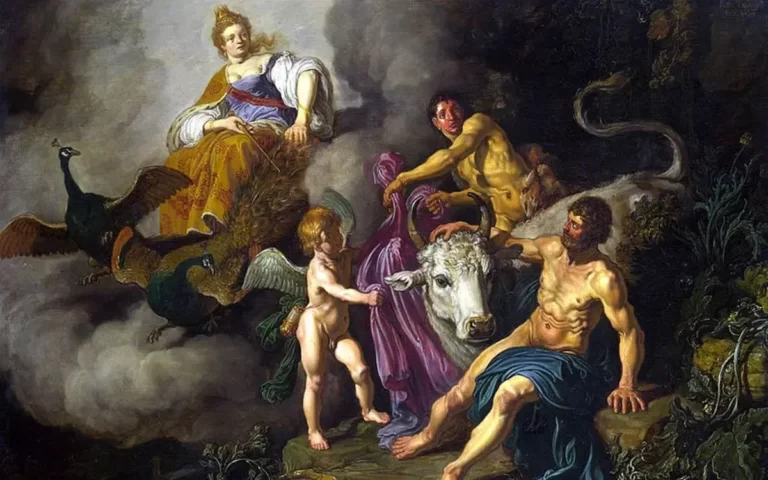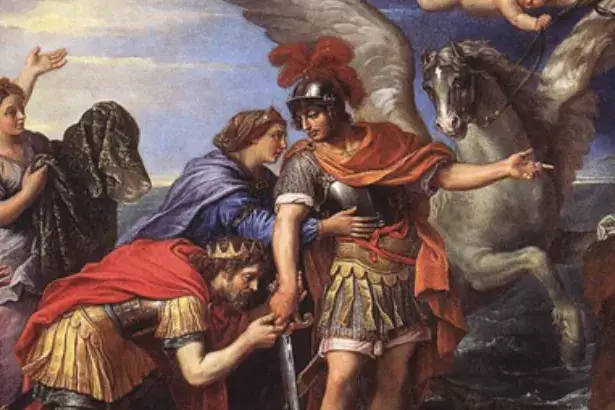Brigid – goddess of fire, healing, and poetry
Brigid is a significant goddess in Irish mythology, revered for her association with fire, healing, and poetry. She is considered a triple deity, with three aspects: goddess of fire, goddess of healing, and goddess of poetry. Brigid is widely worshipped in Ireland and her influence is felt in modern Celtic culture. In this article, we will delve deeper into Brigid’s history, mythology, and influence in modern times.
overview of Brigid, the goddess of fire, healing, and poetry
Brigid is a prominent goddess in Irish mythology, associated with various domains including fire, healing, poetry, and smithcraft. She was highly revered in ancient Ireland and is still venerated by many today. Brigid is known for her nurturing and compassionate nature, as well as her creative and inspirational qualities. She is often referred to as a triple goddess, representing the three aspects of femininity: the maiden, the mother, and the crone. Brigid’s influence can be seen in many aspects of Irish culture and traditions, and her legacy continues to inspire people around the world.
Significance of Brigid in Celtic Mythology
Brigid is a significant goddess in Celtic mythology, revered for her role in various aspects of life such as healing, poetry, smithcraft, and childbirth. She was worshiped in both pagan and Christian traditions and her legacy continues to inspire many people today. Brigid’s influence can be seen in many aspects of Celtic culture, including art, music, and storytelling. Her importance is highlighted by the fact that she is one of the few deities to have survived the transition from paganism to Christianity in Ireland, where she is now revered as a saint.
The Origins of Brigid
Brigid is believed to be one of the most ancient and widespread goddesses of the Celtic pantheon, and her origins can be traced back to the pre-Christian pagan beliefs of the Gaels in Ireland. Her name means “exalted one” or “high one,” and she was revered as a goddess of fire, fertility, healing, and poetic inspiration. Brigid’s origins are shrouded in mythology, with various legends and stories attributing different genealogies and attributes to her. She is often depicted as a triple goddess, with three aspects: the maiden, the mother, and the crone. Her importance in Celtic mythology is reflected in the many festivals and traditions associated with her worship throughout Ireland and other parts of the Celtic world.
Historical background of Brigid’s mythological origin
Brigid’s origin is rooted in Irish mythology, where she is one of the most prominent deities. She is often referred to as a triple goddess, as she is associated with three different aspects of life: fire, healing, and poetry. Brigid’s origins can be traced back to the pre-Christian era of Ireland, where she was worshipped as a goddess of fertility, agriculture, and craftsmanship. Over time, her importance grew, and she became associated with other domains, including wisdom, warfare, and divination. Brigid’s prominence in Irish mythology continued even after the introduction of Christianity to Ireland, where she was eventually adapted into the figure of Saint Brigid, one of the country’s patron saints.
The Celtic festival of Imbolc and its association with Brigid
Imbolc is a Celtic festival that is celebrated on February 1st, marking the beginning of spring. It is also known as St. Brigid’s Day, as it is closely associated with the goddess Brigid. This festival is traditionally celebrated by lighting candles, wearing white clothing, and decorating homes with fresh flowers and greenery.
In Celtic mythology, Imbolc is the time when Brigid is said to renew the earth with her fire and bring fertility to the land. She is also associated with healing and inspiration during this time of year. Brigid was said to bless the hearth and home, and Imbolc was a time to clean and purify one’s house in preparation for the coming spring.
Imbolc is still celebrated by many people today, particularly in Ireland and Scotland, as a way to honor the goddess Brigid and celebrate the changing of the seasons.
The Three Aspects of Brigid
In Celtic mythology, Brigid is often depicted as a triple goddess, representing three different aspects of her character. These aspects are commonly known as:
- Brigid the Poet – This aspect of Brigid is associated with the art of poetry, which was highly valued in ancient Celtic culture. Brigid was said to inspire poets and bards, and her association with poetry also extended to other forms of creative expression, such as song and storytelling.
- Brigid the Healer – As the goddess of healing, Brigid was revered for her ability to cure illnesses and injuries. She was often invoked by healers and physicians, who would seek her guidance and assistance in their work. In some traditions, Brigid was also associated with midwifery and childbirth, as well as with the healing power of springs and wells.
- Brigid the Smith – This aspect of Brigid is associated with the art of metalworking, particularly with the creation of intricate jewelry and weaponry. Brigid was revered as a patron of blacksmiths and metalworkers, who would often invoke her aid in their craft. She was also associated with the transformative power of fire, which was used to shape and purify the metal.
These three aspects of Brigid are often depicted as interconnected and complementary, symbolizing the multifaceted nature of the goddess and the many roles she played in Celtic culture.
Explaining Brigid’s three aspects: Fire, Healing, and Poetry
Certainly! Brigid is often associated with three different aspects, each representing a different domain or sphere of influence. The first aspect of Brigid is fire, which is seen as representing her role as a goddess of creativity, inspiration, and transformation. As a goddess of fire, Brigid is often associated with the hearth and with the burning of sacred fires.
The second aspect of Brigid is healing. This aspect of Brigid is often associated with the use of herbs and other natural remedies to promote physical and spiritual health. Brigid’s healing abilities are said to be so powerful that she is often invoked to help with everything from physical injuries to emotional wounds.
The third aspect of Brigid is poetry. As the goddess of poetry, Brigid is often associated with the bardic tradition of Ireland. She is said to inspire poets, bards, and other artists to create their best work. This aspect of Brigid is also linked to the power of language and the ability to use words to create magic and meaning.
Significance of each aspect of Celtic culture
Each aspect of Brigid holds a significant place in Celtic culture. Fire is essential for warmth, cooking, and light, making it an important part of daily life. In Celtic mythology, fire is also seen as a symbol of inspiration and transformation, representing the energy needed to spark creativity and drive change.
Healing is another important aspect of Celtic culture, as it is believed that Brigid has the power to cure illnesses and injuries. As a goddess of healing, Brigid is often associated with sacred wells and springs, which were believed to have healing properties.
Finally, poetry is highly valued in Celtic culture as a means of storytelling and passing down history and legends from one generation to another. Brigid’s association with poetry represents the power of language and the importance of preserving cultural traditions through oral tradition.
Brigid in Irish Folklore
In Irish folklore, Brigid is often depicted as a saint and Christian nun who founded a monastery in Kildare. This portrayal of Brigid is thought to have emerged during the early Christianization of Ireland when the Christian church appropriated the stories and attributes of the pre-Christian goddess Brigid to create a new Christian saint. This process of syncretism was common in early Christianity, as it allowed the church to integrate pagan beliefs and practices into the new Christian religion.
The stories about Saint Brigid often incorporate elements from the pre-Christian goddess Brigid, such as her association with fire and her ability to perform miracles. Saint Brigid is also associated with healing and hospitality, which are important virtues in Celtic culture. The monastery in Kildare that Saint Brigid is said to have founded became an important center of learning and hospitality, where people from all over Ireland could come to learn, seek healing, and find shelter. Today, Brigid is still venerated as a saint in Ireland, and her feast day on February 1st is celebrated as the festival of Imbolc.
Famous stories and anecdotes of Brigid
One famous story of Brigid is about her influence on the creation of the famous Brigid’s Cross. The story goes that one day, Brigid visited a dying pagan chieftain named Ruadan. She sat by his bedside and began weaving rushes into a cross shape, explaining the story of Christ’s crucifixion as she worked. The chieftain was so moved by her story that he converted to Christianity before he died.
Another popular story involves a leper who came to Brigid for help. He asked her to bathe him in milk, but she only had enough to fill a single tub. Despite this, Brigid was able to miraculously bathe the man in the tub of milk, and he was completely healed.
In another story, Brigid is said to have turned a pool of water into beer to quench the thirst of some weary travelers. This act of generosity has been attributed to the creation of the traditional Irish beverage, mead.
These stories and many more illustrate Brigid’s reputation as a kind and compassionate figure in Irish folklore, as well as her association with miracles and the power of healing.
Brigid’s association with Christian saints and her influence on Irish Christianity
Brigid’s significance in Irish culture is so immense that even after the arrival of Christianity in Ireland, her legacy continued. One of the most interesting aspects of Brigid’s influence on Irish Christianity is the association between the goddess and Saint Brigid, one of the most important Christian saints in Irish history.
The legend goes that Saint Brigid was born in the fifth century and that her mother was a Christian and her father was a chieftain who worshipped Brigid the goddess. The saint was said to have been named after the goddess and had many of the same attributes as the deity, including healing and the ability to provide abundance.
It’s believed that the stories of Brigid the goddess were woven into the legend of Saint Brigid and that many of the saint’s miracles were attributed to the power of the goddess. The saint is said to have established a monastery in Kildare, which was believed to have been built on the site of a temple to Brigid the goddess. The nuns who lived in the monastery were known as the “daughters of Brigid.”
Even today, many Irish people celebrate the feast day of Saint Brigid on February 1st, which is also the date of the Celtic festival of Imbolc, which is associated with the goddess Brigid. The saint’s feast day is celebrated with many of the same traditions and rituals as the festival of Imbolc, including the making of Brigid’s crosses and the lighting of candles.
Overall, Brigid’s association with Christian saints and her influence on Irish Christianity highlights the enduring importance of the goddess in Irish culture, and how her legacy has continued to shape Irish traditions and beliefs over the centuries.
Brigid in Contemporary Culture
Brigid’s legacy and influence can be seen in contemporary culture in many ways. Her association with fire has led to her being honored in modern neo-pagan and Wiccan traditions during festivals such as Imbolc, which is celebrated on February 1st or 2nd. Some people also honor her by lighting candles or fires in her honor.
Brigid’s connection to healing has inspired many to seek her assistance in matters of health and well-being. In modern times, some people turn to Brigid for emotional and physical healing, and she is often invoked by healers and those in need of healing.
Finally, Brigid’s association with poetry and the arts has led to her being seen as a patroness of creativity. Many writers and artists today honor her by dedicating their work to her or seeking her inspiration.
In Ireland, Brigid is still a popular figure in folklore and is celebrated annually on February 1st, which is also St. Brigid’s Day. In recent years, there has been a renewed interest in Brigid and her legacy, and many are rediscovering her as a symbol of feminine strength and empowerment.
Influence of Brigid on Contemporary Celtic and pagan spirituality
Brigid continues to be a revered figure in contemporary Celtic and pagan spirituality. Many modern practitioners honor her as a goddess of healing, creativity, and transformation, and they incorporate her into their rituals and ceremonies. Some also view her as a protector of women and a symbol of feminine strength and resilience.
Brigid’s association with fire, healing, and poetry makes her a versatile figure in spiritual practice. Fire is seen as a purifying force, healing represents the restoration of the body and mind, and poetry is viewed as a way to connect with the divine and express oneself creatively.
Many people also associate Brigid with the changing of the seasons and the renewal of life, particularly during the festival of Imbolc. Some modern practitioners celebrate Imbolc as a time of new beginnings and growth, and they honor Brigid by lighting candles, making offerings, and performing healing rituals.
Overall, Brigid’s legacy continues to inspire people to connect with the natural world, express their creativity, and honor the divine feminine.
The modern-day celebration of Imbolc and how it honors Brigid
Imbolc is still celebrated by many people today, particularly those who follow contemporary Pagan and Wiccan traditions. The holiday typically falls on February 1st or 2nd and is associated with the first signs of spring and the return of the light after the darkness of winter.
In modern-day celebrations, Imbolc is often focused on honoring Brigid as the goddess of fire, healing, and poetry. Some common rituals include lighting candles or a fire in honor of Brigid, creating corn dollies or other crafts to represent her, and performing healing or divinatory practices.
In Ireland, the town of Kildare is particularly associated with Brigid and her traditions. The site of a monastery founded by St. Brigid in the 5th century, Kildare is home to a modern-day center for Brigidine spirituality and pilgrimage. Visitors to the site can explore the holy well and flame associated with Brigid, as well as participate in workshops and other events focused on her traditions.
Conclusion
Brigid is a prominent figure in Celtic mythology, revered for her associations with fire, healing, and poetry. Her three aspects are deeply rooted in Celtic culture and have continued to influence contemporary Celtic and pagan spirituality. Brigid’s mythology and folklore have left a lasting impact on Irish culture, as evidenced by her association with Christian saints and her influence on Irish Christianity. The celebration of Imbolc continues to honor Brigid and her legacy in modern times.






